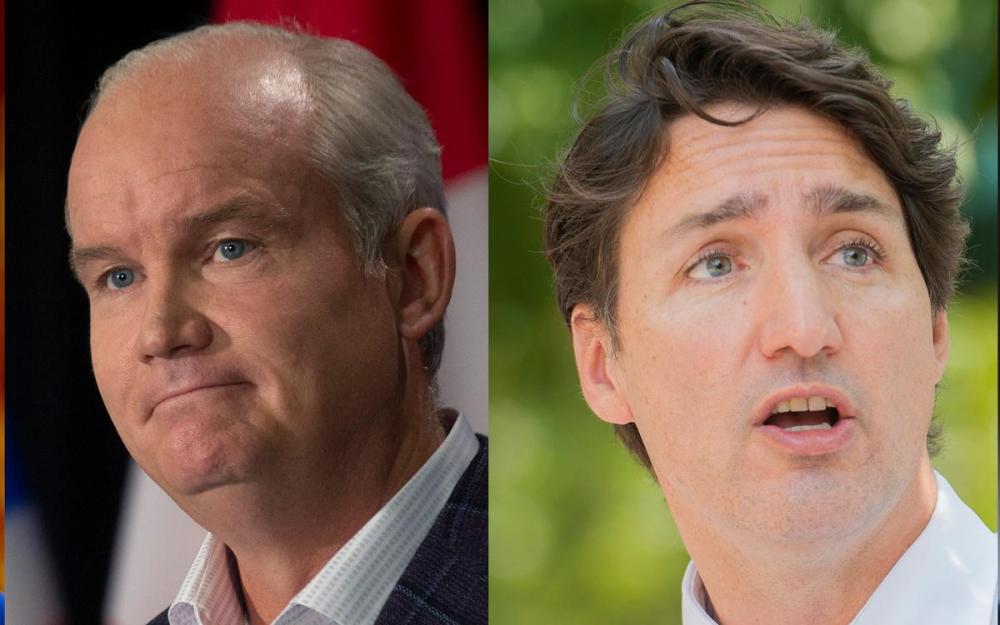Liberals retake the lead in projected seat count but more voters still support Conservatives, poll analysis says
Advertisement
Read this article for free:
or
Already have an account? Log in here »
To continue reading, please subscribe:
Monthly Digital Subscription
$19 $0 for the first 4 weeks*
- Enjoy unlimited reading on winnipegfreepress.com
- Read the E-Edition, our digital replica newspaper
- Access News Break, our award-winning app
- Play interactive puzzles
*No charge for four weeks then billed as $19 plus GST every four weeks. Offer only available to new and qualified returning subscribers. Cancel any time.
Read unlimited articles for free today:
or
Already have an account? Log in here »
Hey there, time traveller!
This article was published 06/09/2021 (1208 days ago), so information in it may no longer be current.
OTTAWA—With less than two weeks left in the federal election campaign, the latest polling analysis shows that Justin Trudeau’s Liberals have recovered their lead in the projected seat count, but the Conservative party still has the support of more voters.
According to The Signal — Vox Pops Labs’ election forecast for the Star — if an election were held on Sept. 7, the Liberals would pull in 143 seats to the Conservatives’ 138.
At the start of the month, the projection pegged Erin O’Toole’s Conservatives at 154 seats in the House of Commons, with the Liberals coming in at 126. The Liberals held 155 seats before the election was called, 15 shy of a majority.

But the Tories continue to outpace the Liberals in popularity; the party has the support of 34.5 per cent of voters, compared to the Liberals’ 31.5 per cent.
The New Democrats are holding steady with 37 projected seats and 19.9 per cent support. The Bloc Québécois would win a projected 19 seats and has six per cent support. Maxime Bernier’s People’s Party of Canada is no longer on track to win a seat but is holding steady with 3.5 per cent support.
“It tells us how tight this race is, how volatile the vote seems to be, how integral Ontario is to determining the outcome of the election,” said Clifton van der Linden, a political scientist at McMaster University and founder of Vox Pops Labs.
“If you look at regional shifts, the real, sort of, salient shift seems to be in Ontario, where you had a strong Conservative lead last week, which has turned into a neck-and-neck race.”
The Signal’s analysis is produced from a model that takes a “poll of polls” going back to 2009. It also accounts for each political polling firm’s “house bias” and compares those surveys against election results.
Tuesday’s analysis added the results from seven new polls released over the past six days.
Some of the polling data was collected after the French-language debate on Sept. 2, meaning that the new findings may have been influenced by the leaders’ performances in the Quebec-focused event.
The Tories did not see a bump in the province following the debate, the analysis shows.
“We saw some momentum for the Conservatives in Quebec last week, but that seems to have plateaued,” van der Linden said.
“The Conservatives still need to make some significant headway, either with a sweep in Ontario or a combined, in-parallel strategy in Quebec, in order to advance ahead of the Liberals in terms of seat share,” he added.
The Liberals and Conservatives have gone head to head over the wedge issue of gun control in recent days, with O’Toole backpedalling on his party’s platform stance on Sunday by promising to maintain the list of prohibited firearms the Liberals put in place in 2020.
New federal modelling on the future of the COVID-19 pandemic, meanwhile, gave O’Toole and the NDP’s Jagmeet Singh another opening over the Labour Day weekend to blast Trudeau over his decision to call an election during the ongoing public health crisis. The modelling showed the number of COVID-19 cases could rise dramatically this month.
But with two more debates scheduled for this week — another French-language jousting match on Wednesday, followed by the first English-language debate on Thursday — the field could be wide open for the final stretch of the campaign.
“It would be really interesting to see if we start to see a shift as a result of these debates,” van der Linden said, citing 2015’s Munk Debate on foreign policy as a turning point in that race.
“(That) was when we suddenly saw the Liberals catapult in terms of their vote share. And they rode that wave in the final third of the campaign to victory in a majority outcome.”
Raisa Patel is an Ottawa-based reporter covering federal politics for the Star. Follow her on Twitter: @R_SPatel


